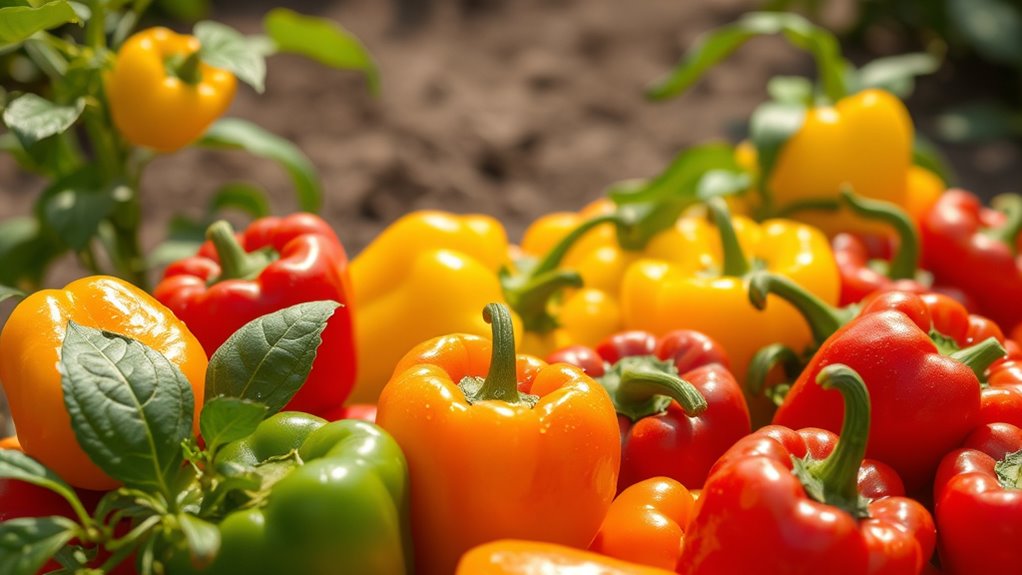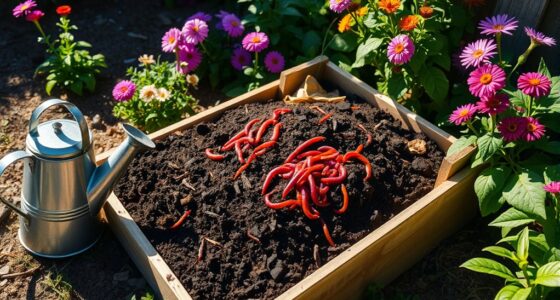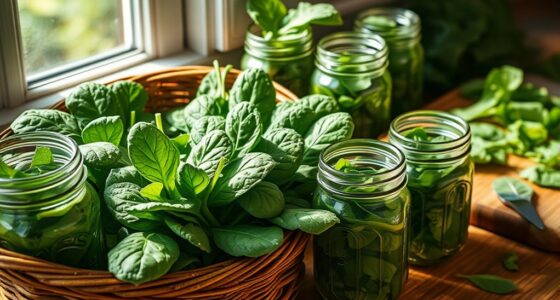To grow peppers, choose a sunny spot with 6 to 8 hours of sunlight and well-drained, organic-rich soil. Start your seeds indoors 6 to 8 weeks before the last frost. Transplant them once the soil reaches 70°F, spacing them 18 inches apart. Keep your plants well-watered with about an inch per week and consider using mulch to retain moisture. Want to know which cultivars work best for your garden? There's more to discover!
Key Takeaways
- Start seeds indoors 6-8 weeks before the last frost and transplant when soil reaches 70°F.
- Choose sunny locations with well-drained, organic-rich soil for optimal growth.
- Space plants 18 inches apart to ensure adequate air circulation and moisture access.
- Water consistently, aiming for about 1 inch per week, and apply light fertilizer at planting and during fruiting.
- Harvest peppers when they change color, using kitchen shears to avoid damaging the plants.
Pepper Site Requirements

When it comes to growing peppers, the right site requirements are essential for a successful harvest.
You'll want to choose a location that receives 6 to 8 hours of full sun each day, as this is critical for both hot peppers and sweet peppers. A well-drained soil rich in organic matter is important; incorporating compost or peat moss can greatly enhance soil texture and fertility.
Aim for a soil temperature between 70 to 80 degrees Fahrenheit during planting for ideal germination. Start your piper plant seeds indoors 6 to 8 weeks before the last frost date and transplant them outdoors once frost risks are gone.
Remember to space your plants 18 inches apart in rows, ensuring proper air circulation and soil moisture access.
Suggested Cultivars
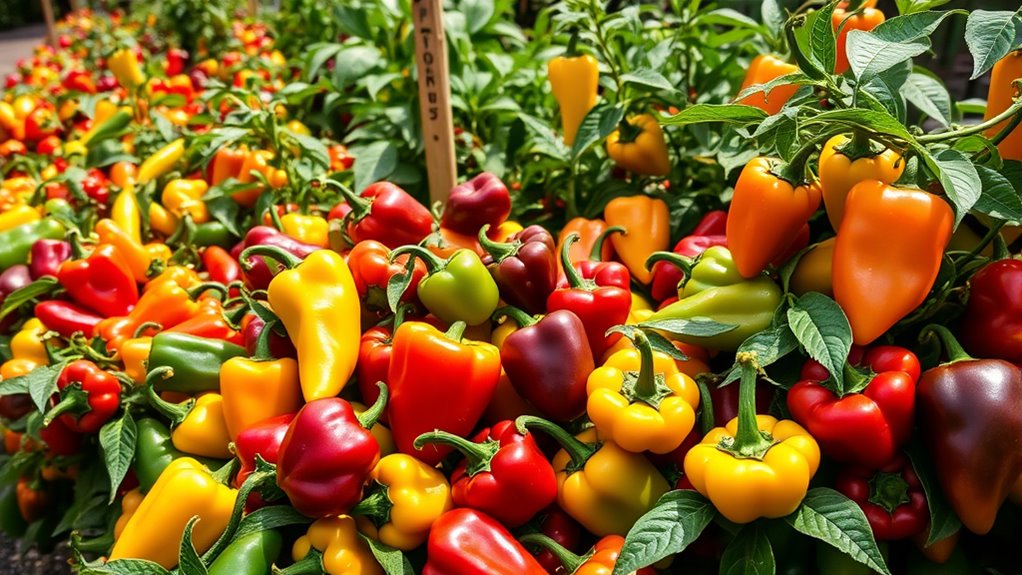
Choosing the right pepper cultivars can make all the difference in your garden's success. For sweet options, consider growing Poblano/Ancho peppers, perfect for chiles rellenos, or the NuMex Joe E. Parker, known for its thick walls ideal for roasting.
If you're after heat, try Jalafuego, a bold jalapeno hybrid, or the versatile Big Boss Man, which combines poblano and ancho traits.
Don't overlook Padron peppers; while typically mild, they can surprise you with their heat.
These popular peppers come in a variety of colors, fitting perfectly in containers for those with limited space. Additionally, the rise in sustainable practices in gardening is encouraging many to explore organic growing methods for their peppers.
Explore different members of the Capsicum species to enhance your growing season and enjoy the diverse flavors they bring to your meals.
Planting Techniques

To successfully plant peppers, start your seeds indoors about 6-8 weeks before the last frost date, typically in January or February.
After the last frost, wait until soil temperatures reach at least 70°F, around mid-May, for transplanting seedlings outdoors.
Choose a sunny spot and make sure you space your pepper plants 18 inches apart, with 24-30 inches between rows for ideal air circulation.
Conduct a soil test to confirm you're using well-drained, organic-rich soil. If needed, amend heavy soils with sand and compost.
At planting, apply a light fertilizer (5-10-10) and maintain consistent watering of about 1 inch per week for healthy growth.
Following these planting techniques will set your peppers up for success!
Care and Maintenance
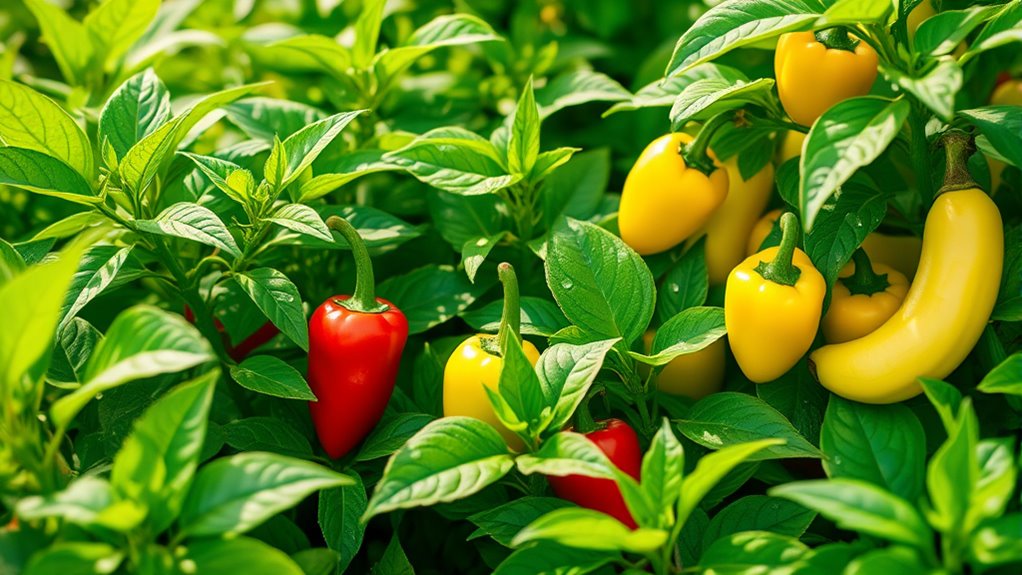
Caring for your pepper plants is essential for a bountiful harvest. To maintain healthy growth, water your plants generously, aiming for about an inch per week. During dry spells, increase watering to keep the soil moist. Applying mulch around your plants helps retain moisture and reduces watering frequency during heat. Use a light fertilizer, like 5-10-10, when planting seedlings and again when the first fruits appear to support sweet bell and other varieties. If you're growing taller peppers, provide support with stakes or tomato cages to prevent damage.
| Care Aspect | Recommendation | Purpose |
|---|---|---|
| Water | 1 inch/week, more in dry spells | Maintain moisture |
| Fertilizer | 5-10-10 at planting & fruiting | Promote healthy growth |
| Support | Staking or cages | Prevent damage from wind |
Harvesting Tips
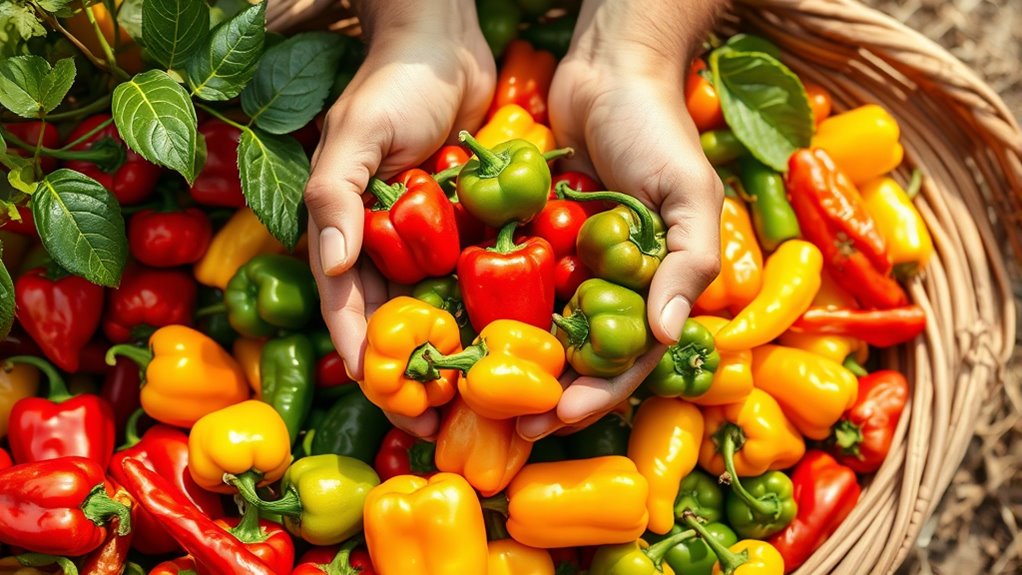
Once your pepper plants have thrived under proper care, it's time to focus on harvesting.
Start by monitoring for ripeness; many peppers will change color from green to their final hue, indicating they're ready to harvest. Bell peppers should reach about 3 to 4 inches in length and feel firm before they're harvested.
Monitor your peppers for color change and size; firm bell peppers should be 3 to 4 inches long for optimal harvesting.
Use kitchen shears to cut ripe peppers, ensuring a clean cut and preventing damage to the plant. Handle harvested peppers carefully to avoid bruising, as they can be delicate.
After harvesting, store harvested peppers in a cool, dry place, ideally at temperatures between 45-50°F with high humidity, to maintain their freshness.
Enjoy your bountiful harvest!
Frequently Asked Questions
Can Hot Peppers and Sweet Peppers Grow Together?
Yes, you can grow hot peppers and sweet peppers together in your garden. They thrive in similar conditions, needing full sun and well-drained soil.
Just make sure you space them about 18 inches apart for good airflow. Keep an eye on watering and fertilization to promote healthy growth.
Be aware that cross-pollination might make your sweet peppers taste a bit hotter, but that's part of the fun of gardening!
Can Sweet Peppers Cross Pollinate With Hot Peppers?
Yes, sweet peppers can cross-pollinate with hot peppers since they belong to the same species.
When this happens, the resulting seeds might produce plants with unpredictable heat levels. You won't know how spicy the fruit will be until you grow those seeds.
To avoid unwanted cross-pollination, keep different pepper varieties at least 500 feet apart or stagger their planting times.
This way, you can maintain the flavor profiles you desire.
What Does Epsom Salt Do for Pepper Plants?
Epsom salt boosts your pepper plants by providing essential magnesium and sulfur. This helps improve photosynthesis, leading to healthier plants and better fruit quality.
You'll notice more vigorous growth and higher yields, plus it can prevent blossom end rot caused by calcium deficiency.
Applying Epsom salt can also enhance the flavor of your peppers, making them sweeter and more aromatic.
Just mix it into the soil or use it as a foliar spray every few weeks!
What Are the Easiest Hot Peppers to Grow?
Imagine biting into a fresh jalapeño, grown right in your backyard. If you're looking for the easiest hot peppers to grow, jalapeños are your best bet. They thrive in warm climates and can produce fruit in just 63 days, perfect for beginners.
Other great options include poblano and Padron peppers, both of which require minimal care while offering unique flavors. You'll enjoy the satisfaction of a successful harvest in no time!
Conclusion
Whether you're dancing with the heat of fiery jalapeños or savoring the sweetness of bell peppers, growing your own peppers can be a delightful journey. With the right site, careful planting, and attentive care, you'll cultivate a vibrant garden bursting with flavor. As you harvest your colorful bounty, picture the joy of adding a personal touch to your meals. So roll up your sleeves, dig in, and let your gardening adventure sizzle with every pepper you grow!

